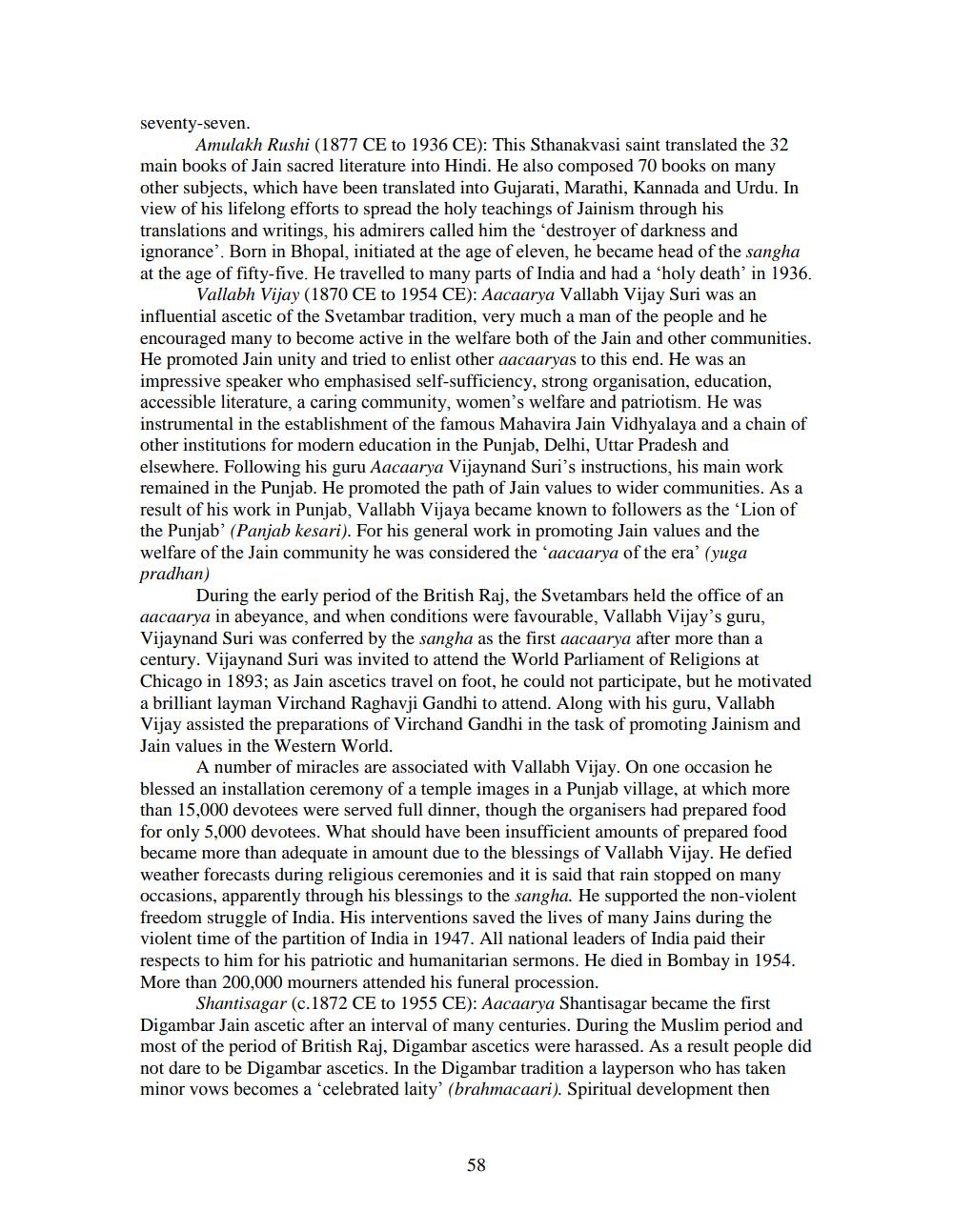________________
seventy-seven.
Amulakh Rushi (1877 CE to 1936 CE): This Sthanakvasi saint translated the 32 main books of Jain sacred literature into Hindi. He also composed 70 books on many other subjects, which have been translated into Gujarati, Marathi, Kannada and Urdu. In view of his lifelong efforts to spread the holy teachings of Jainism through his translations and writings, his admirers called him the destroyer of darkness and ignorance'. Born in Bhopal, initiated at the age of eleven, he became head of the sangha at the age of fifty-five. He travelled to many parts of India and had a 'holy death' in 1936.
Vallabh Vijay (1870 CE to 1954 CE): Aacaarya Vallabh Vijay Suri was an influential ascetic of the Svetambar tradition, very much a man of the people and he encouraged many to become active in the welfare both of the Jain and other communities. He promoted Jain unity and tried to enlist other aacaaryas to this end. He was an impressive speaker who emphasised self-sufficiency, strong organisation, education, accessible literature, a caring community, women's welfare and patriotism. He was instrumental in the establishment of the famous Mahavira Jain Vidhyalaya and a chain of other institutions for modern education in the Punjab, Delhi, Uttar Pradesh and elsewhere. Following his guru Aacaarya Vijaynand Suri's instructions, his main work remained in the Punjab. He promoted the path of Jain values to wider communities. As a result of his work in Punjab, Vallabh Vijaya became known to followers as the 'Lion of the Punjab' (Panjab kesari). For his general work in promoting Jain values and the welfare of the Jain community he was considered the 'aacaarya of the era' (yuga pradhan)
During the early period of the British Raj, the Svetambars held the office of an aacaarya in abeyance, and when conditions were favourable, Vallabh Vijay's guru, Vijaynand Suri was conferred by the sangha as the first aacaarya after more than a century. Vijaynand Suri was invited to attend the World Parliament of Religions at Chicago in 1893; as Jain ascetics travel on foot, he could not participate, but he motivated a brilliant layman Virchand Raghavji Gandhi to attend. Along with his guru, Vallabh Vijay assisted the preparations of Virchand Gandhi in the task of promoting Jainism and Jain values in the Western World.
A number of miracles are associated with Vallabh Vijay. On one occasion he blessed an installation ceremony of a temple images in a Punjab village, at which more than 15,000 devotees were served full dinner, though the organisers had prepared food for only 5,000 devotees. What should have been insufficient amounts of prepared food became more than adequate in amount due to the blessings of Vallabh Vijay. He defied weather forecasts during religious ceremonies and it is said that rain stopped on many occasions, apparently through his blessings to the sangha. He supported the non-violent freedom struggle of India. His interventions saved the lives of many Jains during the violent time of the partition of India in 1947. All national leaders of India paid their respects to him for his patriotic and humanitarian sermons. He died in Bombay in 1954. More than 200,000 mourners attended his funeral procession.
Shantisagar (c.1872 CE to 1955 CE): Aacaarya Shantisagar became the first Digambar Jain ascetic after an interval of many centuries. During the Muslim period and most of the period of British Raj, Digambar ascetics were harassed. As a result people did not dare to be Digambar ascetics. In the Digambar tradition a layperson who has taken minor vows becomes a 'celebrated laity' (brahmacaari). Spiritual development then




